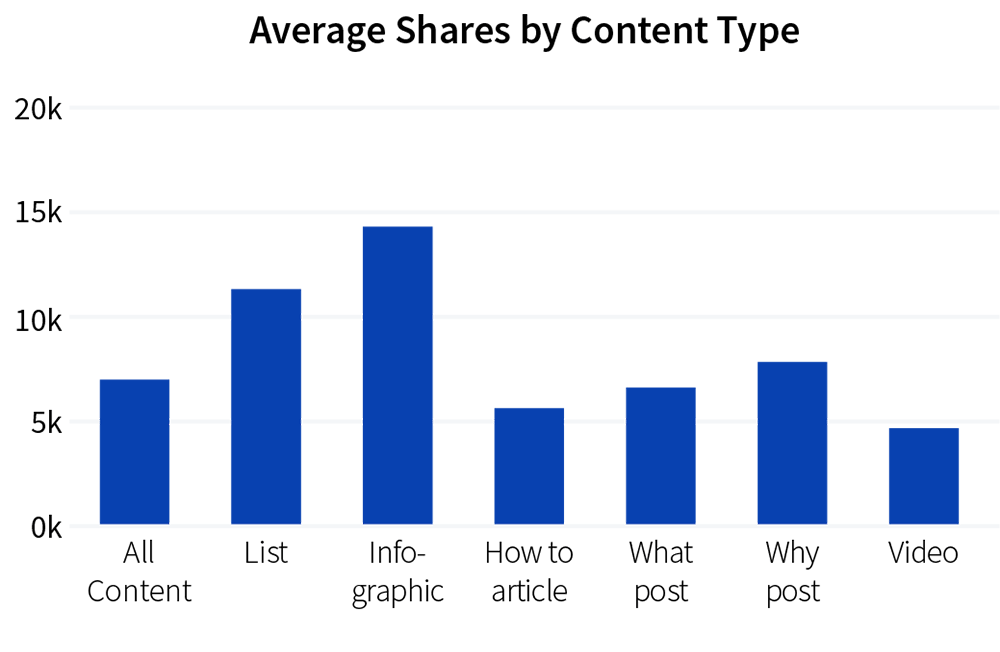Continue Reading
Talent Attraction and Engagement
The first pillar of Hiring Success, Talent Attraction & Engagement, emphasizes an organization’s ability to reach top talent with a combination of inbound and outbound recruiting strategies. The most successful companies rely on cutting-edge tactics and channels to attract and engage candidates in personalized, genuine ways. With 70% of candidates not actively seeking new jobs—but being open to them—companies looking to remain competitive need to ask themselves the following question: How do we effectively capture the attention of talented prospects (both internal and external)?
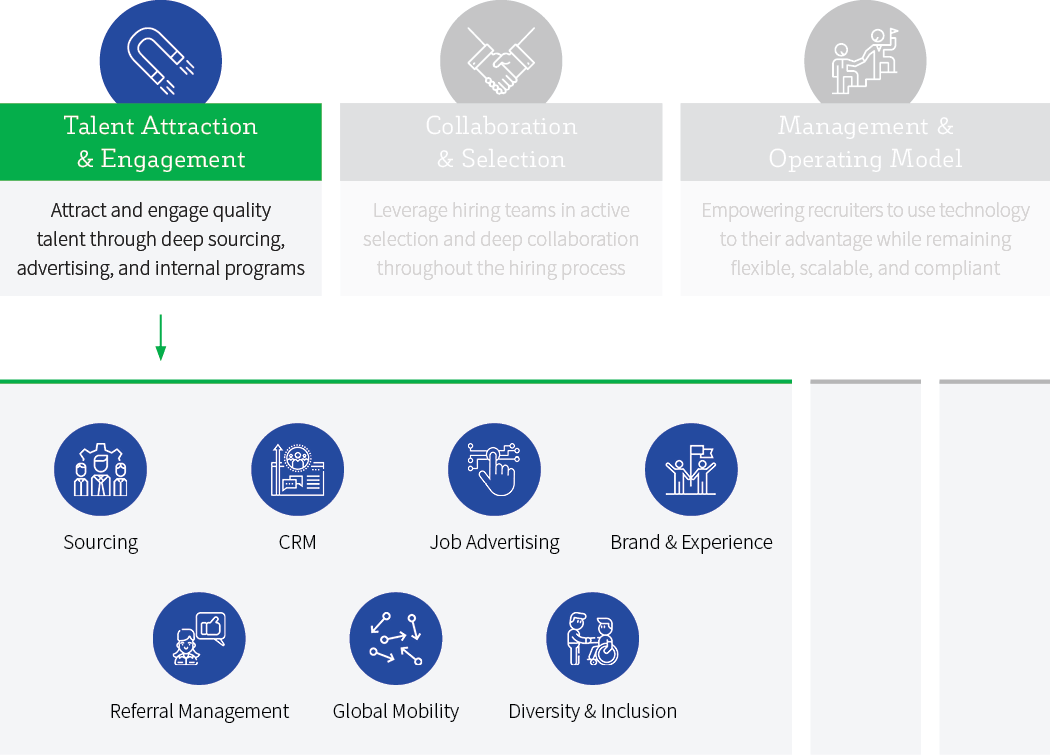
Segment Your Needs: Talent Scarcity-Impact Framework
Just like marketing segments customers, recruiters should segment hires—as in, identify who you are trying to hire. It’s useful to map the talent you’ll need to specific objectives for your company. We recommend segmenting your hiring goals according to criteria like skills, experience, and education so that you can custom tailor hiring strategies for each segment. This allows you to work backward and determine what specific capabilities within Talent Attraction & Engagement you will need to prioritize.
This approach to hiring doesn’t come without its challenges, and we recommend using the Talent Scarcity-Impact framework. This model segments candidates using two factors:
- How vital and impactful is this person’s role?
- How scarce is this person’s specific skill set?
You can also map your hiring targets to this framework by taking the following steps:
- List all the target roles you need to hire.
- Determine how impactful each role will be for the business. Think about key success factors for your organization such as product roadmap milestones, sales goals, etc.
- Determine how scarce the skills are for each required role. For example, software engineers with experience in machine learning algorithms are quite scarce, while entry-level retail candidates may be more readily available.
- Finally, plot each role in one of the four quadrants from the Talent Scarcity-Impact framework illustrated below.
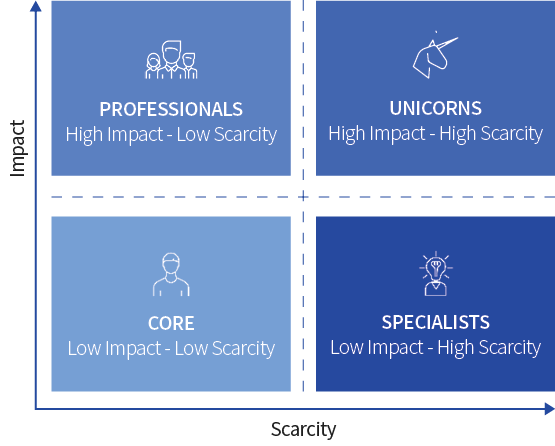
Each of these categories should be handled uniquely with concern to messaging, promotional channels, and budget.
Unicorns: High Scarcity – High Impact
These hires typically possess a rare mix of high impact skills, are hard to find, and offer immense business value. In the healthcare sector, an example would be neurosurgeons. In the financial sector, star traders and analysts. Unicorns are typically looking for roles in high growth organizations where they can make an impact by contributing their expertise and, in turn, strengthen their personal brand. To attract these candidates, TA teams need to focus on strong employer branding and using specific, personalized messaging or content that resonates with the potential hire’s personal and professional ambitions.
Again, since unicorns are scarce, valuable, and highly sought after, in order to successfully recruit them you’ll need to allocate considerable resources—specifically for direct sourcing. Typically, hiring candidates from this segment increases the overall hiring budget. For example, executive search firms typically charge 20-30% of a new hire’s first-year salary as commission. The entire hiring budget for most organizations normally falls in the range of 5-20%.
Specialists: High Scarcity – Low Impact
These candidates have less individual impact, but are still difficult to source. Nurses, lab technicians, financial advisors, and software engineers are all examples. These candidates usually gravitate toward opportunities in companies that will develop their careers. Since these workers are also difficult to source, they’re in a position to be selective when choosing a new employer. To attract these candidates, TA teams should rely on developing a robust brand identity.
Hiring these candidates also requires significant investment. For a company with an overall hiring budget of 5% (total recruiting costs / new hire payroll), this segment may necessitate a hiring budget of 5-7%.
Professionals: Low Scarcity – High Impact
These hires are relatively easy to find and drive high organizational impact. For example, mid-level managers, marketers, sales representatives, and consultants. They do provide considerable organizational value and, consequently, have modest leverage when choosing an employer.
Hiring strategies for these candidates require less targeted precision and can be executed more cost-effectively. For a company with an overall hiring budget of 5% (total recruiting costs / new hire payroll), this segment may have a hiring budget of 3-5%.
Core: Low Scarcity – Low Impact
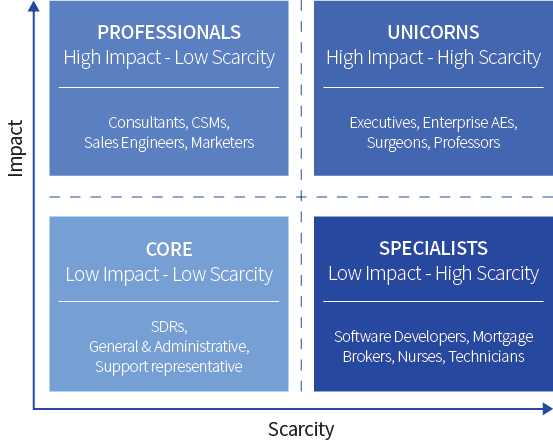
These hires are relatively easy to find and have limited individual impact. Employees that assist with back office, administrative functions, and support functions are examples. TA teams can attract most of these candidates through mass marketing. However, it’s still important to be discerning and invest wisely when selecting new hires in this segment, as they’re often well-suited for internal mobility.
Similar to professionals, attracting and hiring Core staff can be accomplished through cost-effective, mass targeting. For a company with an overall hiring budget of 5% (total recruiting costs / new hire payroll), this specific segment may have a hiring budget of 2–5%.
Hiring Success in Action Building a Hiring Plan
Now that you have a better understanding of candidate segments, and how they relate to your marketing efforts and budget, we can build a hiring strategy. We’ll use SmartRecruiters as an illustrative example.
SmartRecruiters is a SaaS company whose flagship product is an enterprise-focused recruitment platform. With close to 300 employees in five countries across the world, our organization is scaling rapidly. In order to keep pace, we’ll need to come up with a hiring plan that’s capable of sustaining our long-term goals.
After reviewing our growth targets and factoring in churn, we predict that we’ll need to hire 100 new employees across all segments:
To meet our hiring needs, we are prepared to invest 5% of New Hire Payroll into recruiting—in other words, our Hiring Budget for the year will be 5%. The 100 people we need to hire will have an average salary of $100,000, which means we will have $500,000 to invest in total (5% * 100,000 * 100). Based on the guidelines mentioned above, we’ll allocate the following investments into each segment and prioritize the following channels:

30 PROFESSIONALS
$72,000 for professionals
(30 hires * 80k salary * 3% Hiring Budget)75% Programmatic Job Ads
25% Direct Sourcing

20 UNICORNS
$280,000 for unicorns
(20 hires * $200k salary * 7% Hiring Budget)85% Direct Sourcing
15% Job Ads

30 CORE
$36,000 for core
(30 hires * 60k salary * 2% Hiring Budget)> 90% Job advertising

20 SPECIALISTS
$90,000 for specialists
(20 hires * $90k salary * 5% Hiring Budget)80% Full-time marketer to run campaign & meet-ups
20% Job Ads
Sourcing
Direct
The notion that “good candidates don’t apply” suggests that companies need to proactively source them, with direct sourcing being an effective outbound strategy. Making direct contact with prospective applicants by telephone, email, and social media can be resource-intensive, as it asks recruiters to “cold call” high-quality candidates. As such, this practice is often reserved to recruit for high scarcity roles such as unicorns and some specialists (e.g., upper management, technical, and professional positions).
Recruiting in the digital age, where social media’s popularity has reached dizzying heights, means knowing where to go to find potential candidates is essential. Whether you’re recruiting developers or designers, you need to leverage the internet in a niche way to find these people. LinkedIn Recruiter has established itself as the go-to source for quickly identifying candidates that align with your job criteria and messaging them directly via InMail. However, it is important to note that LinkedIn is not necessarily the only channel for all types of roles or regions around the world. More specialized channels must be explored for a well-rounded, diverse sourcing strategy.
Direct sourcing requires organizations to promote themselves as an “employer of choice.” This means having a strong brand and reputation that excites candidates at the possibility of working there. Organizations engaging in direct sourcing efforts also need to consider the motivations of their candidates when approaching them with new opportunities and leverage those as part of the negotiation process.
Agency
Not all organizations have an internal team to source and fill open positions. For those that rely on outside staffing agencies, careful consideration of internal costs and external staffing agency fees is advisable.
Some agencies and third-party recruiters package their services and charge lower fees (20% of base salary or even lower) under special arrangements, such as when multiple positions need to be filled or when the employer enters into an exclusive partnership with an agency. Some recruiters even charge by the hour for searches whereas others charge a minimal fee upfront and act as the employer’s HR department in coordinating the search.
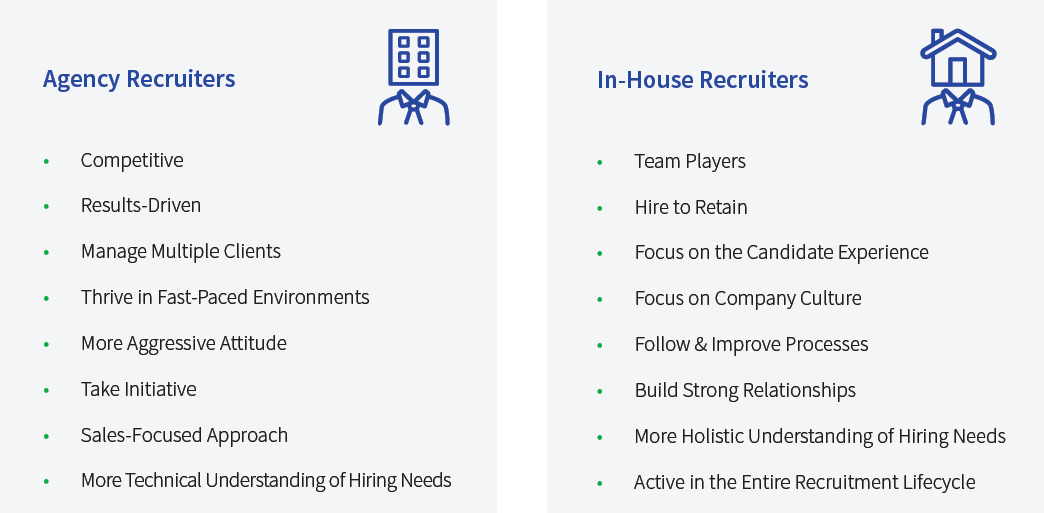
When to Apply Sourcing Tactics
Driven by social media, an abundance of data, and supported by modern outbound marketing software like Outreach, direct sourcing can be a very effective method to attract candidates. It’s tedious and expensive but works well for high-skilled and high-level targets like unicorns and select specialists on a more 1:1 communication model. Scaling this effort to attract core and professional workers is unrealistic, though the popularity of platforms like LinkedIn make it easier to deploy this strategy across multiple role types.
What Yields Success: The Pinpoint Approach
Involve hiring managers or executives when starting your search. If your target is a unicorn or specialist role, communications from upper management can have a strong impact on that candidate’s decision. In practice, this looks like a CEO reaching out to hire someone else in the C-Suite, the VP of Engineering hiring a top data scientist, or a hospital director searching for a head neurosurgeon.
What Yields Success: The Army Approach
Hire a team of junior sourcers to search far and wide for the exact profile you want, continually raising the bar on skills and traits until you find your unicorn candidate. Do not settle. At this point, sourcers can send highly targeted messages on behalf of, or using, a senior leader’s account to drive conversations until a senior recruiter or executive search professional can take over to negotiate and close.
Building Pipeline with Candidate Relationship Management (CRM)
Companies with clear employer brand value proposition can jazz up their career page and profiles on The Muse all they want, but what’s the most relevant method of pushing that information to a target audience? Candidate Relationship Management (CRM) is the technology that delivers that content. This makes CRM an important pipeline-building recruiting tactic.
Examples of common CRM functionality and uses include:
- Social recruiting
- Personalized emails and texts
- Automated invitations to business events
- Email campaigns
- Candidate surveys
- Engagement analytics and scoring
- Candidate segmentation
- Referral programs
There is no reason to treat every requisition like a brand-new search for candidates, especially if you have previously invested energy and effort on assessing candidates who were a good match for your organization. It makes sense to nurture those potential future-fit candidates.
At its core, CRM enables hiring teams to connect with talent ahead of demand. Think sourcing, only before an operational need or organizational vacancy exists. In tight labor markets, CRM provides a bench of pre-qualified talent whenever the need arises.
How Does CRM Work?
Seventy percent of the global workforce are passive candidates. Since the majority aren’t actively looking for jobs, the onus is on sourcers and recruiters to proactively seek out these individuals and build relationships with them. CRM aids this process by facilitating the sourcing, organizing, and nurturing of these candidates.
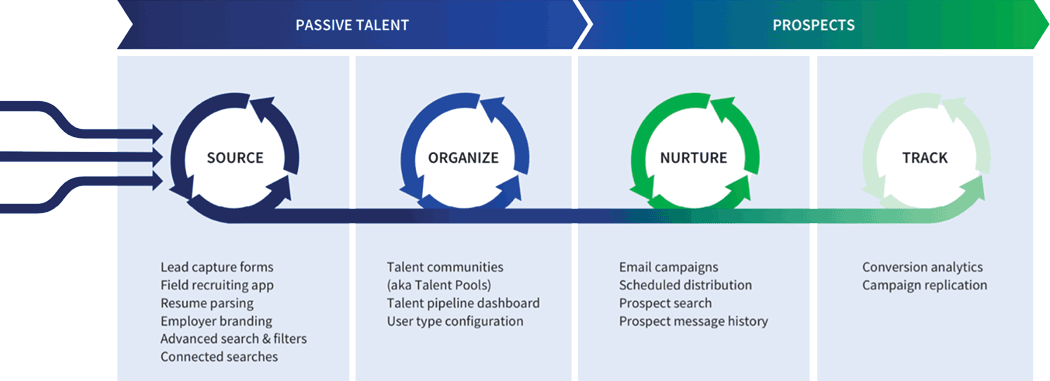
Beginning with sourcing, CRM systems allow sourcers to effectively collect and organize data on prospects while keeping information secure and compliant. Lead capture forms and field recruiting apps gather valuable candidate information at career fairs, live events, or online campaigns. This data is fed into the CRM where sourcers can build databases that can be automatically updated and enriched with relevant—and specific—candidate information. Past experiences, current location, education, and seniority level can all be stored in the CRM to build custom talent communities.
These communities can then be organized by any designated shared characteristic—graduating class, industry, functional meetup, diversity targets, etc.—which can be sorted and managed so that recruiters have ready access to talent for conversion into prospect pipelining. With a pre-assembled community ready for prospecting, sourcing time is reduced dramatically.
Once sourcers build these talent communities, the next step is to nurture the candidates. With CRM, sourcers can communicate with candidates individually or en masse through targeted messaging that strengthens these relationships. HTML email campaigns with unique calls-to-action, social media and web campaigns, impactful content (i.e., videos or employee testimonials), and intelligent advertising spending can be created, customized, and delivered to each of a recruiter’s targeted talent communities.
Between 70-80% of recruiting happens during the pre-applicant stage, so delivering the right messaging to the right people at the right time is critical to attracting passive candidates.
CRM is fundamental to recruitment marketing, and all efforts can be organized, scheduled, and delivered through CRM, eliminating the need for unnecessary team maintenance, and ensuring that the maximum number of talent is converted for each campaign.
When to use CRM
Content marketing via talent pools and CRM is one of the most effective forms of candidate attraction today, as it allows sourcers and recruiters to optimize both quantity and quality of pipeline. As such, CRM is the perfect channel for recruiting hard-to-find specialists (nurses, lab technicians, software developers, mortgage brokers, etc.). Because specialists have specific talents that meet a business goal, they can be grouped into communities with other similar candidates. CRM does not work as well for unicorns as there simply isn’t enough candidate volume for these roles. If done right, CRM can also be leveraged to attract professionals and core staff as a more targeted alternative to advertising.
Hiring Success in Action Retail Sourcing for Peak Season Demands with CRM
A global athletic footwear retailer projects that the shopper traffic and average basket size per shopper for the next holiday season will increase by 20%, and plans to increase the overall number of temporary staff at the same rate in order to accommodate customer service and sales demand.
A regional manager of a key territory in Southern California decides to leverage the CRM system that headquarters just deployed by installing field recruiting apps and lead capture forms on in-store kiosks at the beginning of the year to target shoppers and brand enthusiasts who might be interested in part-time work.
Throughout the year, the manager searches through the existing applicant database, filtering for student resumes, as this group typically has more on-demand availability while off school, and by specific cities within the region to build talent pools for individual stores. The manager also creates a connected search that automatically feeds new resumes captured by store kiosks that meet the student status or city criteria into the pre-configured talent pools.
The regional manager then schedules bi-weekly email campaigns targeted at the specific talent pools that not only promote limited product releases and new collections that are in stock, but also tease store-specific job openings along with larger employee discounts recently approved by head office.
As summer approaches, the manager launches more aggressive email campaigns and posts custom social media messaging across multiple channels to attract students looking for seasonal work, for each store.
After successfully hiring several part-time retail sales associates from the talent pools who are off school on summer break, the manager hosts a family- and friends-only sale event across all stores within the region to further promote the brand and attract potential candidates.
The above pipeline-building strategy is repeated in order to meet seasonal hiring challenges on an ongoing basis.
Building Strategic Talent Communities
For hiring teams getting started with CRM, knowing what kinds of communities to target can feel like a guessing game. A helpful tip is experimenting with low-risk efforts. Begin by launching a university recruiting initiative, which offers the opportunity to test and try different messaging templates, forms, or communications. The goal is to keep candidates warm, so experiment with what works best for a given community.
Another example of companies building strategic communities is Visa’s Ready to Return program, which helps Bay Area women and men looking to re-enter the workforce after a break. Sometimes, life forces us to make the difficult decision to put a career on hold in order to care for family members. Visa’s program gives “returners” the resources and networking opportunities they need to get their careers back on track while combating bias and stigma.
Other examples of possible communities include:
- Top talent incubation: It’s in your best interest to retain top-performing employees at all costs. Cisco Systems implemented a 16-week program called Action Learning Forum where cohorts of high-potential leaders earned the chance to strengthen their skills in leadership, strategic management, and team development while working on real business problems and projects that were fundamental to Cisco’s operations. Roughly 20% of the 360 total participants were promoted, and the company only lost only 2% of program graduates to new positions, illustrating the loyalty generated when high-performers are given developmental opportunities.
- Alumni community: Does your company consistently hire graduates from a select few universities? If so, it’s likely that you are confident in their education and work ethic, as demonstrated by previous hires in your organization. Try building a community around recent or soon-to-be alumni by attending job fairs, career talks, or other meet-and-greets to collect candidate information. This can provide your company with a regular pipeline of vetted, talented individuals year after year.
- Referral community: How much are you leveraging your own employees to source quality candidates? A combination of silver medalists and connections within your employees’ professional networks can easily generate a rich community of prospective candidates. These candidates, on average, have the highest applicant-to-hire conversion rates (40%) and a majority of them remain loyal to their employers longer.
Optimizing CRM Effectiveness
Unfortunately, while 79% of organizations are using CRM, nearly one-third of them are dissatisfied with it. This likely stems from the fact that most sourcers and recruiters lack traditional marketing backgrounds and therefore don’t know how to use CRM tools. At the same time, few hiring organizations invest in reskilling and retraining teams on how to use this new technology. What happens as a result?
– Kyle Lagunas
Former IDC Analyst

As we’ve seen previously, content worth sharing is key to retaining candidates’ attention.
Leverage Automated Messaging
By inserting a talent network form before a job application, you can capture basic candidate information and schedule automated reminder emails, company newsletters, or job alerts through your CRM system.
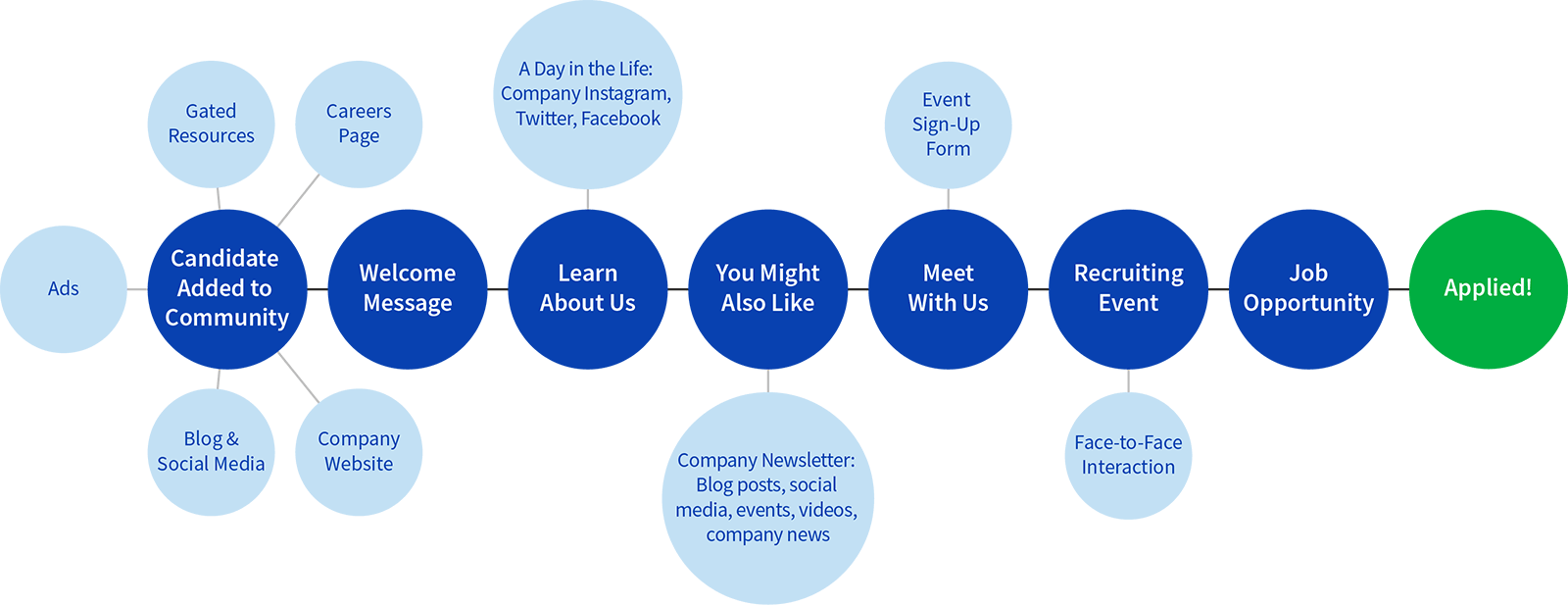
Job Advertising
Traditionally, one of the most widely used recruiting tactics was posting open requisitions in newspaper classified ads. That is until digitalization heavily tipped the scales in favor of online job boards and advertising via professional networks like LinkedIn. This started to drive people towards company profile pages and career sites in hopes of converting them into applicants.
Today, many organizations are experiencing a decline in website conversion rates, a symptom of the fact that candidate attention spans are shorter, causing them to disengage quicker than before. Couple this with a shrinking unemployment rate and many employers find it challenging to effectively advertise their open positions through this channel.
What’s more, companies are pressured to navigate these changes without a clear understanding of what works. Without analytics giving insight into which channels are performing well, many hiring teams still rely on the “spray and pray” method of job advertising, or they only advertise on platforms where everyone else is comfortable, i.e., major channels like Indeed, Glassdoor, ZipRecruiter, etc. The solution for this unreliable practice is programmatic advertising, which we’ll discuss in a later section.
This is not to say that job advertising is ineffective. In fact, this channel continues to be the primary source of hires—attracting $60b spend by companies around the world—because this is where most jobseekers go. The real questions to answer are: 1) In what cases are job ads the most effective? And 2) How can recruiters and marketers ensure that their job stands out to the right candidate? Honing in on this will allow a business to spend on job ads more efficiently rather than spray and pray into nebulous black holes.
Top 15 Job Search Engines for 2019
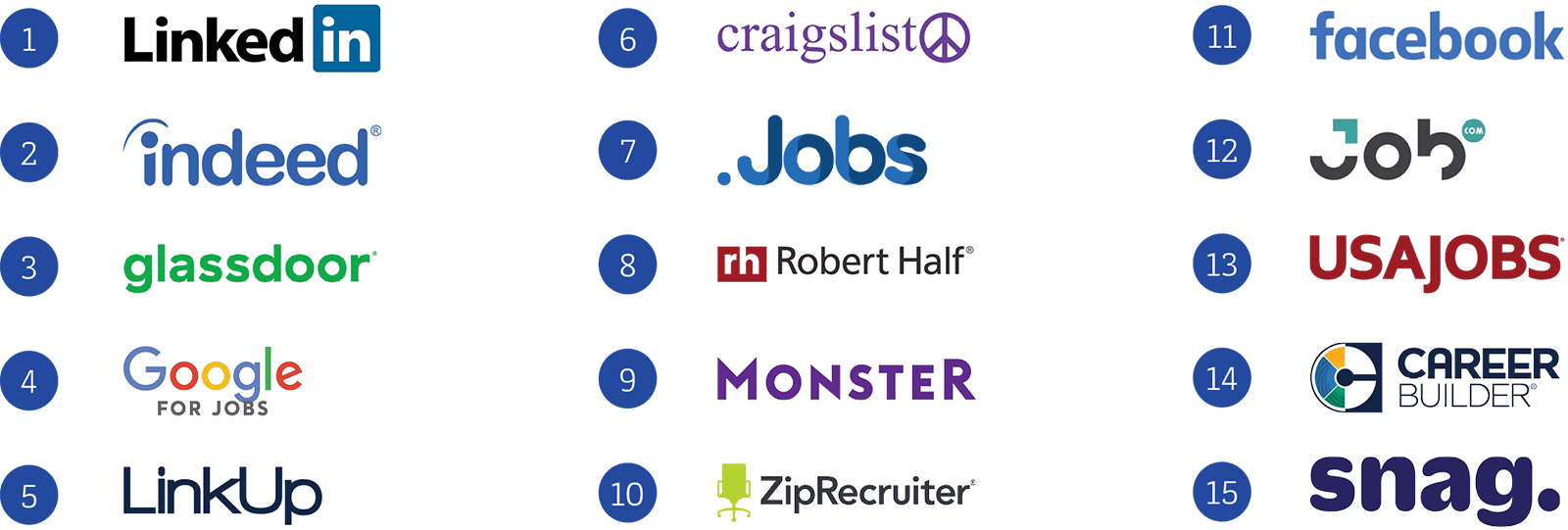
Source: MobileMonkey.com
When to Invest in Job Ads
An all-too-common mistake at many organizations is treating every open position the same. We recommend adapting your advertising strategy based on job criteria, where you are hiring, job market conditions, and more.
Job advertising works most effectively among large populations of job seekers. Referring back to the Talent Scarcity-Impact framework, low-scarcity segments like professionals and core have more individuals searching for new and better jobs, which makes them an ideal group to target through job advertising. You may occasionally get lucky advertising for specialists or even a unicorn, but it can’t be the main channel for High Scarcity segments.
Job Advertising 2.0: Programmatic Advertising
Sounds scary, but it’s not. Moreover, it’s guaranteed to optimize your sourcing budget. Unfortunately, most traditional job advertising today is not performance-driven, and leads to organizations paying more than they should. This poor distribution often results in insufficient application volumes for hard-to-fill jobs and a surplus of candidates for other roles. What’s more, hiring teams often play a guessing game when deciding what to post and where to post. Spray and pray is real here.
U.S. companies spend roughly $4b annually on job advertising and—for companies that measure (and most cannot see it all in one place)—almost half of this budget is wasted, particularly on job boards priced at a fixed rate, and not performance or cost-per-applicant based.
When advertising multiple job boards in parallel, managing budgets centrally also becomes increasingly challenging.
Looking at the example source report below, a company that spends $200k in advertising only sees 4% of candidates converting to interviews, with less than 2% of applicants being hired. Perhaps, unsurprisingly, this happens at almost all organizations.
Example Source Report
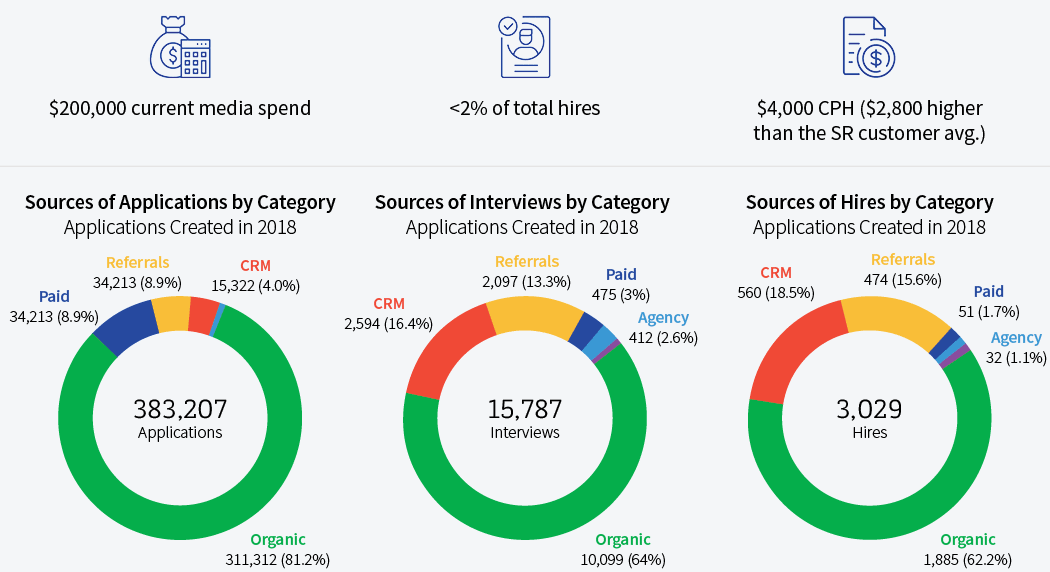
By adopting a programmatic advertising approach, companies are now able to reach candidates more effectively and efficiently with the help of artificial intelligence. BCG research shows that programmatic advertising is over 50% more successful than manual approaches, and offers the additional benefits of greater budget optimization and stronger brand presence across a variety of sourcing channels.
Simply put: programmatic advertising takes the guesswork out of posting job ads. Solutions like SmartJobs use algorithms and machine learning to analyze historical data about job ad performance and makes predictions about where job ads will garner the best response. Rather than manage the same portfolio of job ad vendors, SmartJobs boosts ad presence across a variety of job boards, niche sites, blogs and social sites, industry sites, and geo-specific sites. This raises brand awareness across channels that otherwise may not be on a recruiter’s radar.
At the same time, programmatic advertising automatically allocates budget towards channels bringing in quality candidates, thus eliminating unnecessary ad spend on high-volume, poor-quality candidate channels. For hard-to-fill positions, SmartJobs diverts more budget towards these roles.
Sourcing Analytics
Improving the performance of your sourcing efforts stems from data-backed insights into which channels offer the highest ROI. This is only possible through sourcing analytics. If you are not currently able to view your sourcing analytics in a centralized location, this is a high-priority item to fix. With programmatic advertising solutions like SmartJobs, all sourcing channels can be compared against one another in a dedicated dashboard (see below) to quickly and easily identify which channels are delivering you high-quality candidates.
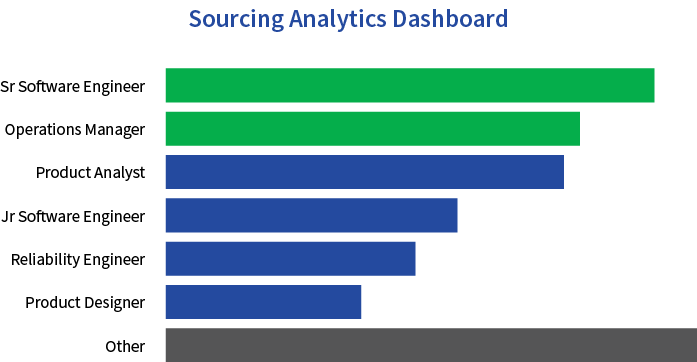
5 Tips to Maximize Job Ad Effectiveness
-
It may seem counterintuitive, but it helps to think about job advertisements as branded content. Having the right content for your audience drives engagement, so when writing an ad, it shouldn’t read like a job description that lists out job functions and responsibilities ad nauseam.
Most job seekers spend 49.7 seconds reviewing a job ad before clicking away, so you’ll want to get to the point and avoid meaningless buzzwords. Use specific language that actually resonates with your audience, or risk losing prospective applicants before they even apply. In fact, 64% of job seekers will not apply for a position if they do not understand what it is about.
- Job ads are about attracting candidates, so focus on the applicant when outlining the desired qualifications, performance goals, and company culture. The overall structure of the ad matters, too. Is it visually appealing with a clear call-to-action? Incorporating a few thoughtful design elements can help your ad stand out from other text-heavy ones.
- Does it touch on aspirational outcomes? Top talent wants to know the added value and impact of this position, and how it aligns with the organization’s culture, so connect it back to core values and how this position will create meaningful influence on the organization. Your ad is not only selling a position, but the company as well, so it needs to demonstrate to candidates that company values are more than just posters hung on conference room walls.
- Lastly, look at the types of channels being used to advertise jobs and determine which types work best for that audience. Large boards like Monster, CareerBuilder, StepStone, LinkedIn, Seek, etc. will draw from a bigger cross-section of the job-seeking population, as will search engines like Indeed or Google. By contrast, niche or industry-specific sites have a more concentrated population of users, which affects the types of applicants coming from those channels.
- Consider investing in programmatic advertising. If you’re finding yourself struggling to draw enough applicant volume or even converting candidates to interview, programmatic advertising tools may be able to help optimize your sourcing efforts.
SEO: Long Game, Lasting Results
Where do candidates look for jobs? Some scour job boards or select career pages, but most candidates begin their search through Google. Currently, 1.28% of all 11.74b U.S. Google searches per month are job-related, equating to 150 million monthly searches. Despite this volume, SEO remains a largely untapped channel for talent attraction. Because few companies take the time to focus on SEO for recruiting, it’s far less competitive than other channels.
However, getting your jobs on the first page of Google search results is not easy. In addition to generating content that boosts a company’s ranking in Google’s algorithm, we recommend doing the following: keyword research and on-page SEO optimization.
Tools like Google’s Keyword Planner can help identify the most popular searches for jobs within an industry.
Utilize keyword research findings to create Careers and Jobs landing pages. There are three types of landing pages that garner the best organic traffic:
- Careers home page
- Career/job category pages
- Individual jobs pages
Each of these pages should be contained within the same subfolder:
- ‘site’.com/careers
- ‘site’.com/careers/job-category
- ‘site’.com/careers/job-posting
It’s fine if your company website uses subdomains like careers.’site’.com, but subfolders are the SEO-preferred method for category page building.
After setting up these landing pages, it’s important to optimize each page for general job searches. The primary method for job landing page optimization is to implement current structured data, also known as Schema for job postings. Thankfully, Google has published extensive guidelines and Schema testing tools, which are available here and here.
Social & Niche Site Advertising
Social media is one of the top tools used for modern job searches, which means a large number of candidates, particularly millennials, already have a presence on these networks. In fact, 96% of the total online population is on at least one social network, making this channel for talent attraction more important than ever before.
Marriott Hotels stands out for its impressive social recruiting strategy. With nearly 1.4 million followers, Marriott Hotels has the largest recruitment page on Facebook. Thousands of people interact with the page each week, searching for available jobs and consuming branded photo and video content about what it’s like to work for the hotel chain.
Moreover, Marriott is highly active on this page, responding to user comments and encouraging dialogue between others. Their Facebook page is purposefully designed to attract the ‘people person’ to Marriott’s employer brand by showcasing what makes them such a desirable place to work.
While technology has made it easier to find talent, it has also made sourcing this talent even more complex and segmented. Social platforms like LinkedIn, Twitter, and Facebook enable companies to reach small, targeted pools of applicants who have likely already connected or engaged with a business. For hard-to-fill roles, niche sites offer even more options to find candidates with highly specialized skills. Websites like Github and StackOverflow are good for sourcing Developers and Engineers, Medium can be leveraged to find Content Writers, and WickedFire or Warrior Forum are hubs for many Marketers.
Creating Content That Resonates
Now that you’ve identified the different channels for promotion, the next step is understanding the types of content that appeal to your audience. This starts with knowing what questions your audience are asking and providing them the answers. Keeping the audience engaged with material worth sharing is critical, whether that be videos, how-to guides, blog posts, images, photography, infographics, podcasts, etc. Closely tied to this practice is creating a dialogue, i.e. engaging in discussion with others on social platforms rather than a one-directional flow of posted content. This helps drive further engagement and builds brand trust.
Looking at the chart above suggests that easy-to-digest material that is engaging, informative, and shareable earns the most traction with candidates.
Part of building great branded content is knowing when to use which types of material. For example, when using hashtags, if they aren’t targeting your key audience—by demographic, geography, or persona— they are redundant. Alternatively, popular hashtags run the risk of burying your messaging in the social media ether. Try being inventive with your hashtags; personalize them to your company and what you want to achieve with them.
Pro Tips
While advertising open jobs is a requirement for all organizations in some countries (e.g., France), it is not in others (e.g., United States). Observing compliance laws around job advertising is vital to how you establish standards for talent attraction best practices.
It is illegal for an employer to publish a job advertisement that shows a preference for—or discourages—someone from applying for a job because of race, color, religion, sex (including gender identity, sexual orientation, and pregnancy), national origin, age (40 or older), disability or genetic information.
- Inclusion of the Unemployed. “Unemployed status” includes current or past periods of unemployment. Federal law does not prevent employers from asking about unemployed status but federal EEO laws do prohibit using this information to discriminate.
- Gender-Referent Language. Employers are strongly advised to use gender-neutral job titles and descriptions in job advertisements. For example, advertising for a “food server” is more inclusive than using “waitress”. One study revealed a 42% increase in applications among companies that removed gender-biased keywords from job ads.
- Ageism. Discouraging job seekers from applying for a non-age-specific position is another form of employment discrimination. Under the Age Discrimination in Employment Act (ADEA), employers aren’t allowed to say they want a “recent college graduate” in a job posting when a seasoned professional twice that age is capable of holding such a position.
Job Advertising Metrics
When talking about job advertising as a marketing strategy, we need to consider what metrics are being used to measure investment and success. Cost-per-Click (CPC) or Cost-per-Thousand Impressions (CPM) are common ways to charge for digital advertising space, but these models aren’t necessarily the best measurements for job advertising. Ultimately, you want to identify how to more effectively spend on advertisements and improve their performance.
The average click-through rate in AdWords across all industries is 3.17% for search and 0.46% for display. Companies charge a range of CPM rates depending on the size of the company or their networks, from $5 CPM to $10 CPM, or higher. For reference, Facebook’s News Feed median CPM has remained around $8.30 for the last three quarters, but spiked at $11.20 early last year. Here’s what the math looks like when we calculate costs within this range:
$5 CPM x 0.46% CTR = 4.6 clicks at $2.30/click
$11 CPM x 0.46% CTR = 4.6 clicks at $5.06/click
Display ads like those in the margins of webpages cannot guarantee conversions, so it’s easy to see how an organization can overspend on ineffective advertising.
Moreover, a CPM or CPC-based model doesn’t hold an organization accountable to make effective ads and optimize them. Rather, their goal is to secure a high volume of impressions without consideration for clicks or conversions. This isn’t good marketing.
Conversion rates are far more compelling metrics when assessing job ad performance. The view-to-apply rate measures how well candidates are engaging with your job ads. Too high of a conversion rate could mean your descriptions are too generic while a low conversion rate could suggest your ad is poorly written.
Looking back at the previous example of gender-neutral language job postings, the impact of content on application engagement is remarkable. In this way, view-to-apply rates offer measurable insight into how well your job ad content resonates with the intended audience and can be a useful reference when AB testing different messaging.
Another good measurement to track is job application completion rate. For most organizations, the application process is one of the most challenging aspects of recruiting. Average application completion rates across all industries are 8% for desktop and 1.5% for mobile. This suggests that most job applications are too tedious or daunting for the vast majority of would-be applicants. Imagine a website landing page where 98.5% of visitors drop off within minutes after arrival. Applications with bounce rates this high strain a company’s advertising budget and hurt its employer brand.
Conversion metrics are a more accurate and holistic measurement of how well job ads are performing—accounting for both spend and content engagement—rather than CPC or CPM models. Job ads are a direct form of communication between your company brand and prospective candidates, so it pays to think about the candidate experience before and during the application stage.
Brand and Experience
A good candidate experience starts before potential candidates even apply and doesn’t end until they show up in the office on their first day. It is also important to create differentiated strategies for each role throughout the entire hiring process.
Employer Brand
of candidates say they first pay attention to a company’s values, then the products and services, and then employee reviews.
In today’s transparent digital world, a company’s employment brand must be both highly visible and highly attractive because candidates now often find the employer, not the reverse. According to Deloitte, 68% of candidates say they first pay attention to its values, then the products and services, and then employee reviews.
The way you portray and market your brand is extremely influential in attracting candidates. In fact, CR Magazine and Cielo Talent showed that almost 50% of workers said they wouldn’t work for a company with a bad reputation, even with a big increase in compensation. Therefore, be sure to showcase your organization’s values, mission, and culture, and give candidates a reason to work for you.
One key component of employer branding is channel selection. Though there are myriad ways to communicate, there are two channels that reign supreme: social media and career websites. On average, 65% of job seekers found the career site to be the most helpful resource and 29% of job seekers use social media as their primary tool for job search. As a result, 92% of companies communicate their employer brand through social media and 64% of companies communicate their employer brand through their career website. As you start building out your hiring strategy, make sure you’re cultivating your brand through social media and your own website.
Hiring Success in Action Accessibility Compliance Through Thoughtful Design
SmartRecruiters’ mission is to connect people to jobs at scale. In order for this to happen, job applications need to be easily accessible. By improving accessibility features on career sites—providing higher visual color contrast, accounting for users who navigate websites without keyboards—we connect disadvantaged candidates with jobs that they deserve, and connect companies with a larger pool of talent.
In January 2019, SmartRecruiters ran a comprehensive audit of our candidate-facing applications, updated these pages for WCAG compliance, and developed a design strategy that ensures future updates and releases follow WCAG guidelines.
At SmartRecruiters, every step of our design and development process is completed with accessibility in mind. Our accessibility compliance is managed by a team consisting of product, design, and engineering team members, all of whom are educated about this topic and oversee all efforts across the organization. SmartRecruiters made a conscious decision to transform web accessibility from a project to a principle by establishing automated testing and a new design protocol to maintain excellent compliance now and in the future.
SmartRecruiters’ new design system—named Blue Steel—specifies the color of components, text, secondary text, buttons, etc. so engineers cannot introduce new issues when building new applications. Specifically, if a developer tries to deploy code that breaks WCAG, it will be blocked until the issue is resolved.
As a result, all career pages hosted by SmartRecruiters score above 90% when tested for site accessibility.
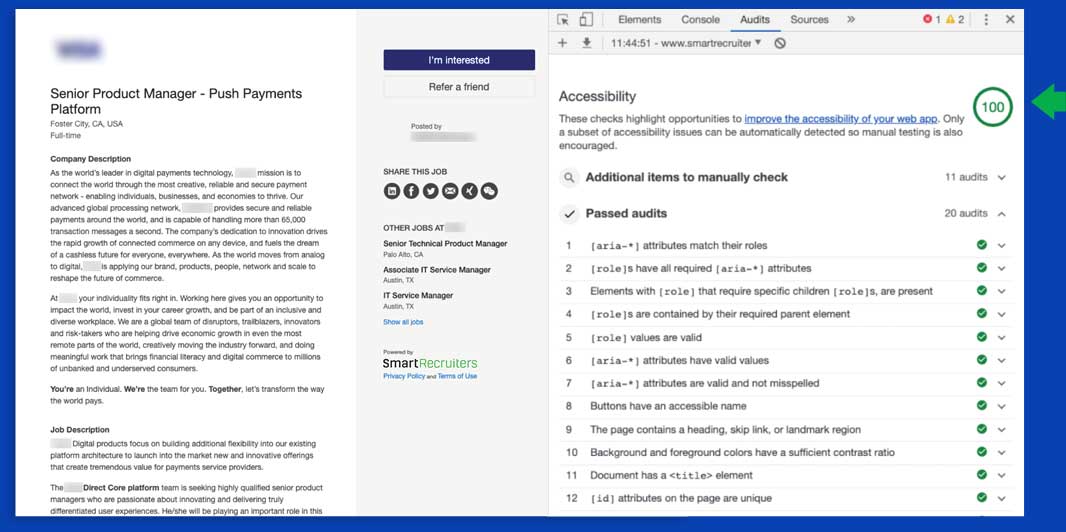
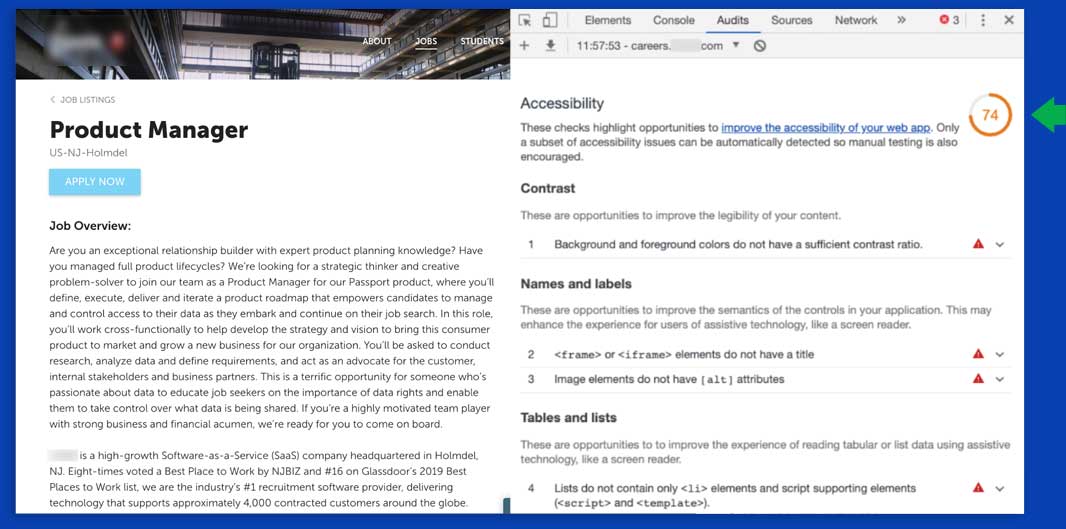
Candidate Experience
One of the key priorities for recruiters should be to ensure a frictionless experience for their candidates. You can start by evaluating your hiring process to identify low satisfaction scores, areas of high drop off, or bottlenecks between stages.
These bad experiences can be turned around. By taking a closer look at where companies commonly fall short at different stages of the hiring process (and taking a moment to reflect on your own process and candidate experience), you can gain insight into what needs to be improved first.
Application Process
The longer it takes to apply for an open position, the more likely a candidate will be to abandon the application and leave with a negative impression of the company. That translates to a smaller inbound pipeline for open roles.
Candidate Engagement
One of the hallmarks of a strong candidate experience is regular communication and seamless touchpoints during the hiring process. To achieve this, recruiting teams must facilitate correspondences between candidates and hiring teams in a timely manner. There are a variety of tools in place that enable recruiters to do so. We have described a couple of emerging technologies under “Intelligence” in the Management & Operating Model Chapter.
To summarize, consider the following when evaluating your organization’s candidate experience.
- Can applicants apply to your jobs with a mobile app? How long does it take?
- How many different ways can an applicant reach your job postings? Are they accessible to everyone—including candidates with visual/physical impairments?
- How do you currently assess your application process? Has your team measured application times against those of competitors?
- Which stage of your TA process takes the longest and why?
- How does your current recruiting technology augment the candidate experience?
- How do you communicate with candidates? Do you provide timely feedback even if they aren’t selected for further consideration?
Hiring Success in Action User Adoption Done Well
Sandi Lurie, VP of Global Recruiting, believes hiring teams should focus on candidate relationship building in the highly
competitive tech hiring space. Beyond running a highly structured and collaborative hiring process, she encourages recruiters to frequently check in with candidates and address any concerns candidates may have. They run a weekly candidates survey through SmartRecruiters to provide timely feedback to recruiters and hiring managers. Sent to every candidate after their onsite interviews, the survey asks candidates to rate their recruiters’ accessibility when it comes to answering questions, providing feedback, and following up, as well as process timeliness and interview panel readiness.
Referral Management
It’s no secret that referrals are a critical element of any recruitment strategy. In fact, 82% of employers rated employee referrals above all other sources for generating the best return on investment. At SmartRecruiters, we see referral programs in practice at many companies within our enterprise customer base, particularly within the Technology and Manufacturing industries.
Amber Hyatt, U.S. Director of Consumer Experience at Johnson & Johnson Vision, argues that employee referrals have excellent conversion rates from interview to hire, as well as typically longer tenure with the organization.” She continues, “Recruiting teams are very aware of the benefits of leveraging employee referral programs to cost-effectively recruit and secure top talent for hard-to-fill positions.”
Travel
After doubling their referral bonus from $2,000 to $4,000, Google saw no significant increase in the number of internal referrals. However, that changed when they started to offer their employees trips to Hawaii as opposed to cash.
Donating to a Good Cause
DigitalOcean launched a new referrals incentive structure in May 2017. For each referral candidate that’s hired, the referring employee receives a $1,500 charitable donation paid by DigitalOcean on the employee’s behalf. By the end of 2017, 40% of DigitalOcean’s new hires were acquired through referrals.
Culture of Recognition
Instead of focusing on referral incentives, Hewlett Packard organizes regular events to publicly honor and thank employees that refer qualified candidates.
Global Mobility
Up until the 1970s, corporations filled approximately 90% of their jobs through promotions and internal hires. Today, internal mobility represents only about a third of all hires. Global brands like Sodexo already know full well the impact of internal mobility—over 50% of their hires are existing employees— compared to 28% at the average company according to LinkedIn’s report on global recruiting trends.
But not every company has that level of brand gravitas. How can businesses build a stronger program so that employees don’t feel like the grass is always greener on the other side?
Start Looking in Your Own Backyard
A recent Gallup Workforce Panel study showed that more than half of employees are actively looking for a new job, reporting interest in expanding their experience, knowledge, and opportunities. Traditional, linear, and promotion-based career paths are losing popularity, particularly as the dominant workforce becomes increasingly comprised of individuals who value titles and hierarchies less than previous generations.
In a job market where finding top talent becomes harder and harder, companies should be keen to retain their existing employees through any means necessary. Hiring your own employees is a lot easier and less risky than bringing on new ones, especially for senior roles or high-impact positions. Ideally, as people move up in the organization, you should be able to replace many of your unicorns with professionals/experts and hire more core individuals to replace them.
Map Out Non-Linear Career Paths to Entry- and Mid-Level Employees
Most employees benefit from having assistance in terms of professional development and long-term career goals. As a talent acquisition leader, you are instrumental in that process. Future career paths can look like experience matrices that offer employees multiple paths towards a desirable goal.
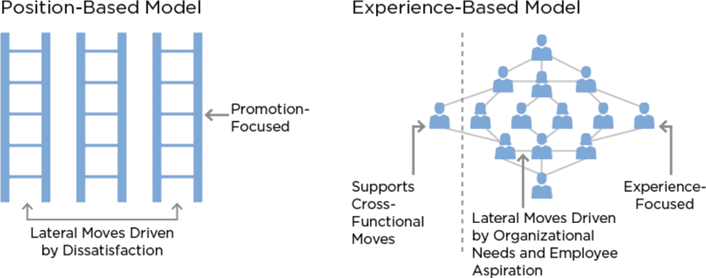
This experiential model empowers employees to develop new skills, knowledge bases, and personal attributes through on-the-job training. In order for internal mobility programs to be effective, however, they have to be clearly communicated to everyone in the organization. Unsurprisingly, when employees are aware of the opportunities that are available to them, they’re more likely to take advantage of them and, consequently, be engaged and productive in the long run.
Creating a Culture of Internal Mobility
While internal mobility programs work best in companies with ample resources, they can be implemented in organizations of all sizes. When developing an internal mobility program, we recommend doing the following:
- Set quantifiable goals and objectives to track performance against metrics like retention, job satisfaction, etc.
- Be transparent and be proactive so employees have ready access to available opportunities, as well as a portal through which to apply as an internal applicant.
- Establish appropriate training and mentorship programs that encourage leaders to help team members broaden their skills and experience.
The third step is key. If leaders and managers hoard talent and resources and don’t embrace the development and professional growth of junior employees, your organization will likely lose them to a competitor.
Focus on Skills Growth, Not Upward Transitions
While “climbing the corporate ladder” was once considered the sole path of career advancement, flatter organizations can benefit from programs that allow employees to move to different teams that share synergies or have overlapping skill sets. This promotes better interdepartmental team relationships and allows for a smoother transition, as internal hires already know your company and culture.
Not only will this have a measurable impact on hiring velocity and budget optimization, but it follows the same best practices as companies that rank highly at being mature talent acquisition organizations. Better yet, it demonstrates to employees they don’t need to leave organizations to be career mobile.
Hiring Success in Action Leveraging Employees to Match Talent with Jobs
A Fortune 500 finance and data security technology firm wanted to redefine its company brand image in a highly competitive market without unnecessary ad spend. The CEO realized that the company could not compete for talent among other companies, declaring that the company faced a marketing problem, citing poor branding as the cause of attrition.
In response, company leadership decided to look at how they were utilizing their database of over 18k employees. They discovered that employees had access to an intranet site hosting internal news, as well as a hard-to-find “current openings” section. Additionally, they realized that their hiring teams had no marketing content to leverage, and recruiters were reaching out to hiring managers directly.
The CEO set a goal to boost internal hires from 24% to 35% in six months.
The company’s solution was to internally apply the attraction principles of candidate marketing. Their first step was to undergo a process adjustment: move the advertising model away from “spray and pray” and focus on internal opportunities first.
To get open jobs front and center, the HR team created an alert widget where employees could register and sign up for newly-opened positions. The team also hosted a series of “lunch and learn” sessions, which boosted awareness about other employee activity within the company. HR leadership also created an SLA around internal discovery, directing recruiters to post new positions internally only for the first 48 hours.
Lastly, the company invested in technology to support these new processes. SmartRecrutiers’ AI recruiting assistant helped promote better internal discovery within their existing database of candidates and employees, and SmartCRM enabled recruiting teams to build internal talent communities ready for conversion whenever a position became available.
These combined efforts resulted in boosting internal hires from 24% to 33% in just four months.
Creating greater opportunities for internal mobility within your organization means looking at how to fill gaps with people, processes, and technology with people already within your organization—and encourage employees to do the same.
Diversity and Inclusion
Research shows that culturally diverse organizations have a competitive edge over their less-diverse peers, both in better average operating results and performance of company shares. What’s more, diverse companies say that a well-rounded workforce creates better products and fosters more innovation, leading to growth in sales and profit.
Pro Tips
- Highlight the existing diversity present at the company and underscore the company’s commitment to D&I in job descriptions.
- Advertise jobs with diverse professional organizations.
- Create a diverse recruiting and/or hiring team.
Diversity and inclusion are an integral part of our business, and a priority for SmartRecruiters as a company. Our highly diverse team builds a diversity-friendly product. Beyond D&I reporting, we build D&I best practices into the product to help users make hiring decisions free of bias. For example, we provide a “cards down” setting for interview scoring, where other scores and reviews are hidden from the user until he or she has provided a review of his or her own. This reduces groupthink. SmartAssistant, our AI product, mitigates human bias during the screening stage by scoring candidates only on the match between their resume and the job description. Our software also empowers customers with open APIs and nudges them to do their best in D&I practices. At the last Hiring Success Conference, we helped one customer build a browser extension that masks a candidate’s name and profile picture to avoid any unconscious bias.
Understand all that constitutes diversity
Diversity is a broad concept that encompasses many attributes: cultures, races, gender, religions, national origins, ages, physical and cognitive capabilities, sexual orientations, and other ways we identify ourselves. These criteria may affect our view of the world and how we interact with our surroundings.
Recognize your own biases, both conscious and unconscious
We all have certain biases—and often we are not even aware of them—but they prevent us from making the best hiring choices. It is worth spending time uncovering biases as a team and putting preventative measures in place. This requires awareness training within the organization to identify sources of unconscious bias in the candidate selection process. AI technology can also help companies systemize objective hiring practices and decision-making processes, but only if humans establish and implement these practices first and generate bias-free training data.
Hiring Success in Action Recruiting for Diversity
A SaaS company specializing in digital experience optimization for large enterprise companies sought to expand its engineering footprint in Austin, Texas, where low taxes, a strong entrepreneurial culture, and a deep pool of talented tech professionals drive the city’s booming tech scene.
Company executives wanted to prioritize diversity hiring among the male-dominant software engineers at the new Austin office, so they implemented a CRM system to strengthen the company’s D&I efforts as the hiring team began sourcing female developers and programmers.
The sourcing manager started by launching custom landing pages on the company career site—one that promotes a meetup event for female coders in greater Austin and another that advertises a diversity-focused scholarship program for female software engineering students at a university with a top-ranked program in the area.
Interested applicants submitted their information through lead capture forms on these landing pages, which fed their profiles into a specified talent pool created by the sourcing manager.
To further engage and nurture prospective talent, the sourcing manager partnered with a recruiter and social media coordinator to set up a company-branded Women at Work Facebook group, tagging the company’s current female engineers to serve as admins and invite their friends to join. Within the group, the hiring team could message group members about meetup events and offer Q&A sessions—either virtually or in person at nearby offices—to talk about the company’s female-friendly perks, benefits, and career programs.
The sourcing manager also created a connected search so that any female candidate with an engineering background is automatically added to a dedicated talent pool for future engagement, regardless of the actual job she applied to.
Tracking campaign analytics, the sourcing manager discovered that emails promoting the engineering scholarship program were collecting a much higher volume of applications and email captures than other marketing campaigns. The manager consequently increased promotion through the Facebook group during the university’s freshman orientation week, in addition to organizing an on-campus event where incoming and graduating engineering students could meet with other female engineers to discuss career opportunities at the company.
As a result, the company was able to hire multiple, top-performing female engineering graduates ahead of their competitors, and this strategy provided the company with a continuous source of talented developers and programmers each year, ensuring the hiring team always has a pipeline of candidates primed for conversion whenever a new position needs to be filled.
Summary
Recruiting has become more closely aligned with a marketing function than ever before. Hiring teams now have to scrutinize the combination of strategies they use to attract top talent to their organizations. To be successful in today’s job market economy, businesses need to leverage a number of the tried-and-true strategies of talent attraction, as well as invest in the strategies that differentiate them from their competition.
Strategies around CRM, conversion rate optimization, programmatic advertising, and referral marketing grant businesses the opportunity to promote their employer brand to evoke authenticity and human-like experiences that attracts and converts the best talent.
If your recruiting function doesn’t have the resources to convert to a digital-first approach, think about how you can leverage current resources (employee testimonials, careers page, revamped job ads, etc.) to drive content that tells the story of what makes your company such a great place to work.
Pro Tips
- Direct sourcing and external recruiting agencies are most effective for scarce segments such as unicorns and some specialists. These roles are few in nature and thus can be sourced through more expensive channels.
- Content marketing and internal mobility are best suited for scarce roles as well. This is especially true for specialists who are looking for what sets your brand apart from the competition.
- Job ads are a great source for any type of role, but are especially useful for low scarcity roles (e.g., professionals & core) as these channels can reach a wider audience without much costs.
